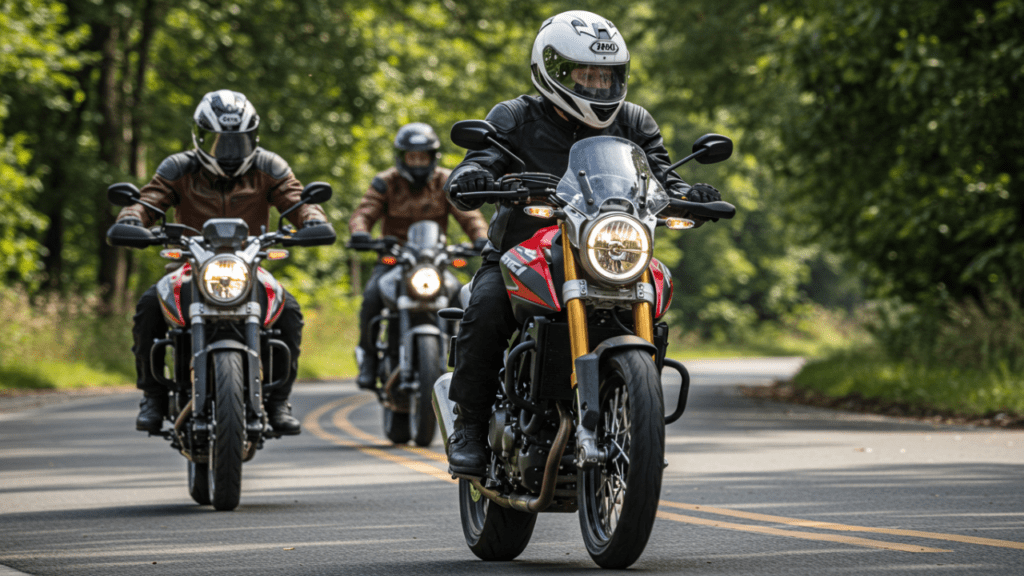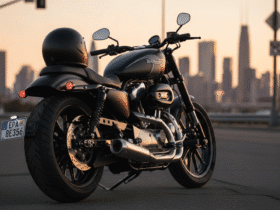The thrill of riding a motorcycle comes alive after acquiring a motorcycle license. However, before everything else, it is essential to understand the costs associated with obtaining a motorcycle license in 2025. This article aims to explain the structure that defines the cost of obtaining a motorcycle license, the costs associated with it, and the most efficient ways to complete it.
What Is a Motorcycle License?
Definition and Purpose of a Motorcycle License
A motorcycle license, like all other vehicle’s licenses, contains information that permits unrestricted access to specific places and guidance on the types of vehicles one is allowed to use.
For one to be able to use a two-wheeled motorcycle, one, they must receive formal education on the various types of motor bikes, their uses, and ways in which they can be safely operated and ridden while ensuring the safety of both the rider and the people who may come across them while in use.
When in possession of a motorcycle license, it becomes possible to operate a motorcycle, legally, with the guidelines and restrictions that come attached to the license. It becomes unlawful to ride a motorcycle without possessing this license in the US. In addition, passing the written exams and practical driving test for using a motorcycle is a prerequisite for obtaining this license.
Types of Motorcycle Licenses
Motorcycle licenses are categorized under two subtypes in the United States;
-
Learner’s Permit: For younger riders this is the first stage to acquiring a motorcycle license. This license enables you to ride under some restrictions (such as ride only during a particular time such as daylight waiting periods with no passengers).Usually this type of permission is valid for a period not exceeding six month’s or a year, subject to the state’s rules.
Contents -
Full Motorcycle License: Once you have experienced riding a motorcycle on a learner’s permit, you can then apply for full motorcycle license. After full licensing, their are no restrictions posed on your riding other than basic road rules.
Factors Affecting the Cost of a Motorcycle License in 2025
The cost of securing a motorcycle license in 2025 will be affected by a number of basic issues such as the state of residence, type of license you are applying for as well as whether or not you wish to undertaker additional useful training courses
State-Specific Costs
The broadest issue when it comes to the cost on a motorcycle discipline is a region is the learners’ residence. Obtaining a motorcycle permit/ license for a particular region has its fees which may vary in process. There state’s fee’s might have a very low upper limit while some may set the maximum fees based on local regulations.
For instance, California collects approximately 35 for the written exam,45 for the road examination, and approximately $25 for the actual driver’s license. As an example, other states like Florida may have lower primary costs and sometimes subsidize the written and road tests.
Checking with the local Department of Motor Vehicles (DMV) will provide the most accurate costs in your region.
Type of Motorcycle License
As with everything Covid related, it so very much depends on the state, and license type, the motorcycle cost entails:
-
Learner’s Permit Fees: The written driver’s test can cost a buyer an additional $10 to 30 on top of paying for the permit itself. Overall, permits vary in pricing among states, but most land within that range.
-
Full Motorcycle License Fees: Similar to learners, full licenses have their own set of state by state differing price ranges. On average a buyer would end up paying between 25-60 max dollars. Again like stated above fees sometimes include the permit which is paid during upgrading, so think on that before buying.
Motorcycle Safety Course Fees
Unlike other fees, this one is optional, but taking a motorcycle safety course could up some slots on your to-do list. Not needed for everyone, but widely accepted, an MSF is encouraged by many states and ranges from $200-500.
-
Why Should You Take One?: Not only does this position some slots on the to-do list, but courses often bring down insurance for some states. Also bypassing skills tests can be redone if safety protocols are followed during check offs for submission.
Examination Fees
-
Written Test Fees: Knowledge tests have a range spanning across $10-30 where showing basic comprehension of the laws is expected. Most purchase the same set of rules who apply to safe driving, road signs and traffic.
-
Road Test Fees: If your state mandates a road test, the fee is usually between 50 and $ 100. Completing an MSF course may allow you to skip this road test, further reducing your expenses.
What Does the Cost Cover?
The cost of obtaining a motorcycle license encompasses various aspects of the licensing procedure.
Application Fees
When you are applying for a motorcycle license, it is compulsory to pay an application fee. This fee addresses the costs for the administrative work needed to check if you fulfill all prerequisites and process your application. The fee is normally between 60 depending on the state you reside in.
Testing Fees
These are associated with the costs for the written knowledge assessment and the riding skills examination. Even though the written test is cheaper than the road test, both of them are important for having a comprehensive motorcycle license. Some states may choose to combine these payments as part of the application procedure.
License Issuance Fees
After accomplishing the required tests, your motorcycle license will be issued to you. The cost of issuing the license ranges from $40, varying from one state to another.
How Much Does a Motorcycle License Cost in Different States?
The ranges provided for a motorcycle license may differ greatly between the states, thus making it important to analyze state by state. Below is a table showing the largest states in the US and comparing their expenses alongside one another.
Average Costs Across the U.S.
-
California: Obtaining a motorcycle license (which includes a written exam, a road test, and the license being issued) costs approximately Dollars 150 on average. Additionally, taking an MSF course comes at a cost of dollars 500.
-
New York: New Yorkers spend $21.50 for the written exam, which is the base fee for a motorcycle license; the road test is included in the application. Completing an MSF course waives the road test requirement.
-
Texas: The cost for a Texas learner’s permit is approximately 25,withthemotorcyclelicensecostingaround60. An MSF course ranges from 250−400.
State-by-State Variations
Some states have lower price ranges than others due to local surveys and legislation. North Carolina and Michigan are known to charge less, while California and New York have higher fees.
Optional Costs That May Apply
Alongside the basic expenses necessary for acquiring a motorcycle license, a few other optional costs can pop up, especially during the registering process.
Motorcycle Safety Course Costs
In most states, enrolling for an MSF course is optional; however, the majority strongly advocate for it. It’s important to note that the course provider and its geographical location dictate the final cost of obtaining the certificate, which ranges from $200 to $500.
-
Why You Should Consider It: In some regions, these courses lower the expense of a road test, but they also make you a safer operator. Riders taking the MSF course even get discounts from many insurance companies.
Renewal Fees
Sustaining permits within the United States often requires periodic renewals. In this case, renewing a motorcycle license should be done every few years. The price tied to renewing a motorcycle license is normally between $20 and $40, depending on the state’s fees.
Additional Costs
-
Endorsements and Restrictions: Riding with a passenger or riding on a motorcycle with a sidecar are considered additional endorsements and restrictions, and some states impose additional costs for these features.
-
Late Fees: Some states impose a grace period for renewing a driver’s license and charge between $10 to $50.
Is a Motorcycle Safety Course Worth the Extra Cost?
Benefits of Taking a Motorcycle Safety Course
Completing an MSF course expands riding skills and improves overall safety when riding. In addition to the relief it affords riders, there are a number of practically useful points to think about:
-
Insurance Discounts: Riders who take a motorcycle safety course are at a lower risk of incidents, thus many insurance companies reward them with lower premiums.
-
Waiver for the Road Test: Some states allow students who complete an MSF course to bypass the road skills test, which is a saver of both time and money.
-
Improved Riding Skills: The precautionary measures taught in the course, such as proper cornering, gentle braking, and hazard avoidance, help make riding a motorcycle a safer activity.
Who Should Consider Taking a Safety Course?
Those who are yet to venture to the world of motorcycles should definitely enroll for the MSF course. It is also ideal for those who have been away from riding for quite some time and want to brush up on skills.
You can also read How to finance a motorcycle with bad credit (2025)
How to Get a Motorcycle License Step-by-Step
Step 1: Check Your State’s Requirements
The prep work shifts attention to the state’s specific detailing as the first priority in the strategy is obtaining a motorcycle license in one’s state must be understood. States have different rules which means the first stop should be the local DMV or its website.
Step 2: Obtain a Learner’s Permit
In most states, obtaining a learner’s permit is compulsory for most people. This will require you to pass a written knowledge examination, and a vision test may also be obligatory. Subsequently, practicing riding will be permitted, but with specific limitations, such as no night riding and no passengers.
Step 3: Take the Motorcycle Safety Course
If your state mandates or suggests it, you may want to look into enrolling in a motorcycle safety course. Often, completion of this course remedies the need to take the road test and equips you with basic exercising riding skills.
Step 4: Pass the Written Test
Completing the written component of the examination should be relatively easy as all you need to do is read your state’s motorcycle handbook. This section includes a variety of questions on traffic laws, road signs, and safe riding practices which are all multiple-choice and easy to understand.
Step 5: Take the Road Test
In the event you did not complete a safety course that waives the road test, one will need to be done after passing the written test. A routine road test usually includes basic skill exercises such as stopping, turning, and controlling the motorcycle.
Step 6: Get Your Motorcycle License
After successfully passing both examinations, obtaining a motorcycle license becomes possible. Normally, this requires a waiting period of some weeks for the DMV to administer these changes, upon which receiving the license in the mail will occur.
My Opinion
On everything concerning riding a motorcycle in 2025, understanding the costs and processes involved in acquiring a motorcycle license is a must. If you are a first-time rider or someone who is getting back on the handlebars after being away for some time, all the direct costs, additional courses, or fees that may arise will definitely be a consideration. Completing the tests and safety courses will put you on the path to legally riding.

















1 Comment